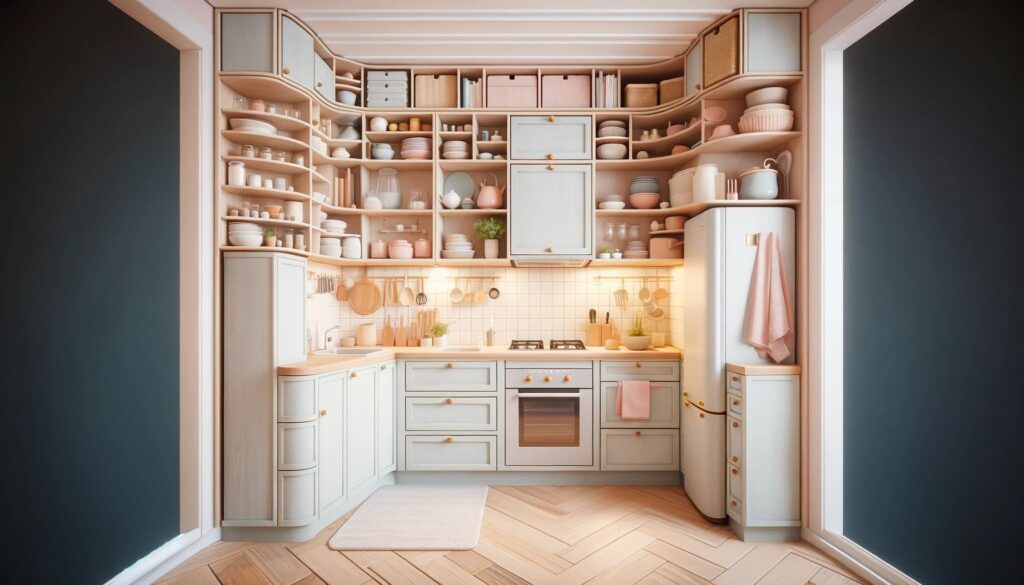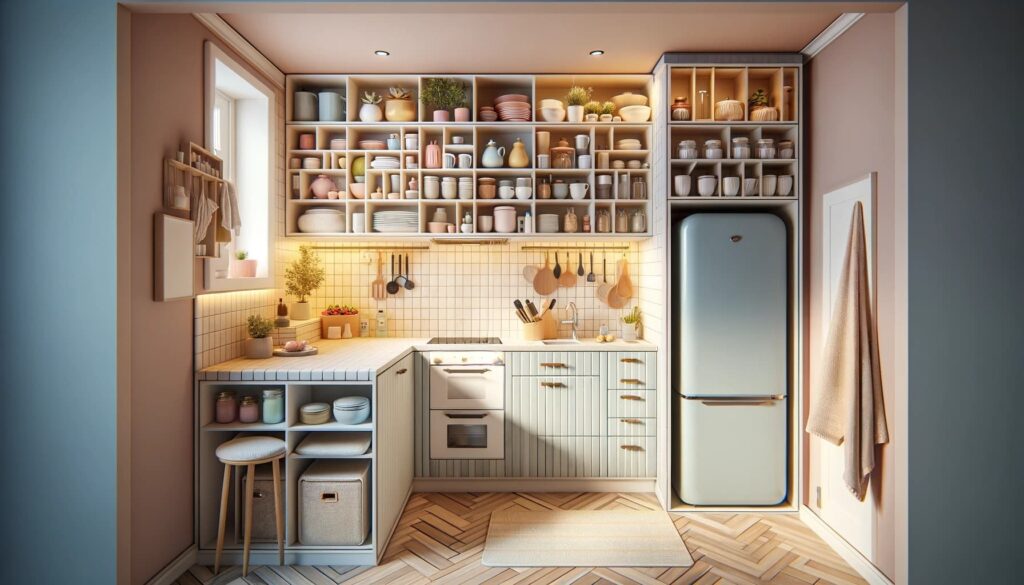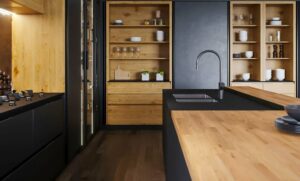Designing a highly functional small kitchen layout comes with unique challenges due to limited space. The key considerations when planning a layout include identifying proper clearance guidelines for appliances and countertops, mapping out key workflow zones to prevent collisions, and maximizing every inch of available space.
With some creative thinking and smart solutions, you can create a small kitchen that makes excellent use of the available square footage and narrow space.
This allows you to cook comfortably while accommodating multiple people. The focus should be on accessibility, efficiency, and taking advantage of vertical storage opportunities.
When executed properly, small kitchen layouts facilitate seamless meal preparation. The strategies below offer clever ways to overcome limited space and create a welcoming, productive environment. Keep reading to transform your small kitchen into a masterpiece of multifunctional design.
Measure Your Small Kitchen Space

The first step in designing your small kitchen is carefully measuring the full space. Pay close attention to the placement of windows, doors, and any existing appliances or fixtures when taking measurements. Sketch out an approximate layout of the tiny kitchen that’s current configuration for reference.
Create Zones Based on Standard Guidelines
With measurements handy, start mapping out zones for key areas:
- Primary workspace and countertops
- Main traffic aisles (at least 42-48 inches wide)
- Appliance clearance zones
- Transitional spaces between zones
Adhere to standard accessibility guidelines throughout, including:
- 60 inches diameter for wheelchair turning space
- Minimum 30 x 48 inch clear floor space for working at cabinets or appliances
- 40 inches width for primary travel aisles
Refine the Layout Focusing on Workflow
Refine your initial layout with workflow optimization as the priority:
- Establish work triangles connecting the sink, fridge, and stove
- Ensure high traffic zones don’t collide
- Test accessibility for users of all mobility levels
The final layout must allow you to effortlessly transition from zone to zone when prepping meals or cleaning. Pay special attention to the triangular workflow between key areas.
Follow Clearance Guidelines
When deciding on appliance placements, cabinet dimensions, and countertop sizes, refer to the following standard clearance guidelines:
- 30-inch clearance between opposing cabinets and countertops
- 48 inches minimum between opposing countertops
- 15-inch total depth for base cabinets
- 60-inches between base cabinets and kitchen islands
- 36-42 inch aisles for primary walkways
Additionally, meet these appliance-specific recommendations:
An efficiently-designed small kitchen maximizes every inch of available space while still meeting standard accessibility guidelines. Compromising on clearance recommendations severely limits functionality.
Map Out Key Traffic Zones
When deciding where to place appliances, storage, and prep areas, first map out the main traffic zones. Mark zones where people will transition from one area to another, such as going from the refrigerator to a other prep space zone. Leave adequate clearance so traffic paths don’t collide.
The main kitchen aisles should have a width of at least 42–48 inches width. If multiple cooks will be working simultaneously, allow more space. Key traffic lanes include:
- Primary travel aisle from the kitchen entry to the stove/sink
- Route between the refrigerator/pantries and the central prep zone
- Access path allowing people to move into and out of dining room spaces
Baking centers and cleaning supply storage should be allocated along the periphery of heavily-trafficked routes. Place items used daily, like major appliances, at intersections of these main kitchen routes.
Optimize With Triangular Workflow
One of the most important elements of an efficiently-designed kitchen is an effective triangular workflow pattern. This connects the three major work zones of a kitchen in close proximity:
- Sink
- Refrigerator
- Cooktop/stove
This forms the focal point of a triangular sequence that closely connects food prep, storage, cooking, and cleanup areas.
Position these appliances in an equilateral triangle formation for optimized movement. Ensure counter spaces and cabinets sit between and open toward these three areas.
In small kitchen designs, look to maintain:
- A maximum of 4-5 feet between zones
- At least 15-30 inches of countertop space in each zone
- Walkways wide enough for multiple cooks as needed
Do a test walkthrough of meal preparation tasks to catch any inefficient transitions between zones. Being able to effortlessly move between washing, refrigeration, and cooking streamlines cooking preps of all types.

Maximize Vertical Storage Space
One advantage small kitchens have is higher ceilings relative to floor space. Take full advantage by installing floor-to-ceiling vertical storage solutions wherever feasible. Common options include:
Wall Cabinets
Install wall cabinets reaching as high up the wall as possible for maximum single-level storage. Just be sure the highest shelves remain accessible. Other considerations:
- Glass cabinet doors create an airier feel
- Pull-down shelves increase access to back areas
- Crown molding finishes cabinets nicely
Pantry Cabinets
For dry goods, use tall and narrow floor-to-ceiling pantry cabinets. Add custom dividers:
- Vertical dividers split single cabinets
- Horizontal dividers create tiered storage
- Pull-out vertical drawer dividers for a pantry cabinet maximize space
Alternative Storage Solutions
Get creative with vertical storage additions like:
- Hanging ceiling-height shelves above the sink or stove
- Narrow floor-to-ceiling shelving next to refrigerators
- Spice, pan, or tray racks mounted vertically on walls
- Paper towel holders mounted high up near prep zones
Take Advantage of All Corners
Corners become prime real estate in a small kitchen. Use them for functional storage that’s easily accessible. Consider the following corner storage upgrades:
Lazy Susans
Install lazy susan corner cabinets maximizing space. Great for blind spots and fitting more with spin access. Choose a full-circle or half-circle lazy susan. Pros include:
- Provides full access to contents
- Available in a range of widths
- Optional built-in dividers for organizing
Vertical Storage
Add on floor to ceiling windows back-to-ceiling pull-out vertical storage units in corners, like:
- Vertical divider cabinets with shelves
- Sliding drawers built high into corner space
- Angled pull-out cabinetry fully utilizing air space
Installing blind corner spin shelves provides two-tiered storage as well.
Additional Corner Storage Designs
Also consider:
- Corner hutches for displaying items
- Upper wall cabinets with integrated diagonal storage
- Custom built-in angled breakfast nook seating
Taking advantage of every corner with specialized storage is key for small kitchen spaces. Work with kitchen designers to customize options maximizing available corner capacity.

Incorporate Multi-functional Furniture
To streamline storage and maximize functionality in dining space, incorporate multi-functional furniture pieces and flexible fixtures. These take on multiple roles depending on kitchen needs.
Multifunction Kitchen Islands
Kitchen islands serve various purposes. Customize mobile islands with:
- Storage cabinets built into the base
- Drop-leaf extensions for more workspace
- Wheels for movable prep stations
- Overhead pot racks freeing up cabinet space
- One section with a raised counter for standing prep
Fold-Down Tables and Seating
Make the most of small empty spaces with:
- Fold-down prep tables doubling as storage
- Banquette seating with storage drawers underneath
- Custom booth seating and tables to save room
Kitchen Carts
Add lightweight carts that serve different functions:
- Baker’s racks providing extra spice storage
- Hutch carts for appliance garage storage
- Bar carts doubling as extra counter space
Multifunctional furniture lets you change up the utility of each area in your very small space or kitchen. Use portable fixtures to modify layouts for different tasks or events.
Clever Small Kitchen Solutions
Small kitchens call for innovation when providing adequate storage. Take advantage of elegant, space-saving upgrades like:
Hidden Trash and Recycling Bins
Install pull-out compartments for trash and recycling under the sink or in the toe-kick area of upper cabinets.. Features include:
- Custom-sized for trash bins
- Mounted on smooth ball-bearing slides
- Automatic or manual open/close
Slide-Out Drawers
Maximize vertical real estate with:
- Full extension pot and pan organizer drawers
- Spice storage drawers
- Tiered utensil dividers and cutlery organizer trays
Tiered Storage
Add dimensional height with:
- Glass-front wall cabinets staggered
- Plate racks suspended under cabinets
- Shelving ledges for small appliances
- Floating breakfront design for depth
With inventive storage options, limited kitchen space seems expansive. Work closely with designers to identify the right mix of vertical space and custom compartments making everything easily accessible.
Conclusion
Designing a superb small kitchen island layout requires prioritizing accessibility, kitchen triangle workflow, and space-saving storage. Measure available space carefully before creating a rough initial layout template. Refine this blueprint focusing on ergonomics and seamless traffic patterns.
Take advantage of the vertical dimension for floor-to-ceiling storage additions. Make excellent use of corner real estate with specialized storage cabinets and hardware. Include multifunctional island carts, drop-leaf dining table side sets, and other flexible fixtures.
They allow modifying the space for different needs while storing essentials.
With meticulous planning, it’s possible to transform even the tightest kitchen into a comfortable, highly-efficient cooking haven. Compromising on critical measurements or failing to coordinate appliances jeopardizes functionality. Get all details and dimensions confirmed before starting renovations.
Some custom fabrication and carpentry may be required when installing specialized storage solutions. Consult qualified kitchen contractors for integrating custom shelving, pull-outs, and built-ins throughout the space. With a thoughtful approach and creative vision, even the most compact of kitchen cabinets can feel expansive.
Transform Your Small Space Into Dream Kitchen
At DreamCatcher Remodeling, we specialize in small kitchen design utilizing clever layouts, natural light and intelligent storage solutions to maximize functionality. Our skilled team brings decades of hands-on experience building and renovating kitchens of all sizes.
We start every project by measuring available space and mapping customer needs. Next we create preliminary layout options for review, focusing on ergonomic triangular workflow and accessibility standards from the outset.
Clients can select cabinetry, countertops, fixtures open shelving, flooring and lighting from our extensive catalogs.
Our in-house craftspeople fabricate custom storage elements like pull-outs, roll-outs, and built-ins tailored to your kitchen’s dimensions. We integrate space-expanding solutions from corner lazy susans to tiered overheads throughout the remodeling process.
To learn more about our small kitchen remodeling services, contact DreamCatcher Remodeling today for a design consultation. We’re happy to assess your current small kitchen ideas and provide quotes for reaching the full potential of your available square footage.






